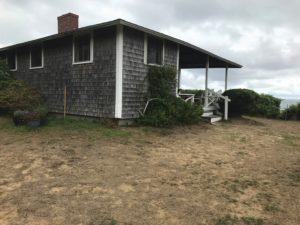EASTHAM — A four-room cottage just northeast of Nauset Light has served as a “magical place” for generations of the Bartlett family since its purchase in 1940, according to Polly (Bartlett) Bryson, one of the 20 grandchildren who have been lucky enough to spend some of their summers on the bluff over the years. Now, because of erosion, preserving the house means it will have to be moved.

When the Bartletts bought the cottage, which was built in 1900, Nauset Light Beach Road and a couple of houses separated it from the steep bank down to the ocean. The shoreline houses fell victim to erosion decades ago, said Polly’s mother, Maggie Bartlett, who recalled that when she was a child her house was still about “a football field” away from the edge. She remembered her father descending the dune with his gear to fish from the beach.
The Nauset Light, a short walk from the house, was still on the ocean side of the road in those days, the elder Bartlett said. “We could go up to the lighthouse with the keeper when he lit the light,” she noted.
The lighthouse was moved 300 feet back from the bluff in 1996.
More recently, the section of Nauset Light Beach Road that ran parallel to the dune became too dangerous to use. It was closed, and a new dirt road to access the cottages was constructed off Cable Road by the town and the National Seashore.
As erosion continued to carve back the sandy bluff, the Bartlett cottage got closer to the edge. Now, a few dozen feet and a dense thicket are all that separate the house from the 60-foot drop to the ocean.
Bryson and her sister Caroline Bartlett, who own the cottage as trustees of Grampy’s Cottage Realty Trust, hope to boost it onto rollers and move it about 120 feet to the very back of the family’s property.
There are no plans to expand the cottage, which is just over 1,000 square feet. The family intends to replace a cesspool with a Title 5 system. Remnants of the cesspool and old foundation will be removed once the house is moved, according to the engineer presenting the plan to the town’s zoning board of appeals.
The ZBA granted the Bartletts a variance from required setbacks from property lines late last month. The family is still waiting for the National Park Service to issue a special use permit, Bryson said. The property is in the Cape Cod National Seashore.
During the zoning board’s hearing on the variance, Amy Thompson, whose cottage is right behind the Bartletts’, expressed concern about the house moving to within 10 feet of her property line. “There will be no more nude showers,” she said. Still, she added that she didn’t want the Bartletts to lose their home.
The bigger issue, according to Thompson, was the driveway plan required by the National Seashore, which she said would route cars up her dirt driveway before turning onto a new dirt access to the Bartlett site.
Thompson said the headlights of cars traveling up her driveway would shine directly into her bedroom, which would be “very unsettling,” she said. “It would be really creepy at night.”
The Bartletts’ attorney, Ben Zehnder, said the driveway approved by the town’s conservation commission and the one originally on the plan was completely separate from Thompson’s.
Getting to the Bartlett property requires crossing Seashore land. “We are just at the mercy of the National Seashore,” Zehnder said, “and they want as little disturbance to their land as possible.”
Lauren McKean, the Seashore planner, said last week that her agency is working with the property owners on a solution. “We’re looking at their deeded rights to the driveway,” McKean said.
The ocean tends to erode the bank in this area at a significant rate, said McKean. “The average has been about five feet per year since 1960,” she said. But “at times we lose more,” she added. “We lost 30 feet of bluff in 2013 and 2014.”
The easternmost section of the parking lot at the lighthouse has lost 20 spaces since 2009. Erosion there took an entire row of parking, McKean said.
The old bathhouses, victims of erosion, were demolished in 2017. New ones, set further back, opened at the beginning of the summer. The stairs down to the beach below the lighthouse had to be replaced several years in a row, prompting the Seashore to eliminate the stairway a few years ago and create beach access via a winding path.
Some property owners have chosen not to battle the effects of erosion and have instead demolished their houses and donated the land. Such was the case in 2018 when Daniel and Lisa Sullivan gave their property at 160 Nauset Light Beach Road to the Eastham Conservation Foundation, after the town deemed their house a danger due to its proximity to the bluff.
A nearby property on Brownell Road in similar circumstances was also donated, according to Henry Lind, president of the foundation’s trustees. “In 1984, another property owner on Seventh Avenue donated the land,” Lind said. “The structure is now the town’s swap shop.”
Changes in the landscape have necessitated house removals on the bay side as well. Joanna Buffington donated her marshfront property near First Encounter Beach to the Eastham Conservation Foundation in 2012, and her house there was “unbuilt” in 2020.
Bryson said her family is grateful to the town for granting the variance and other permits.
Their idea is to buy as much time as possible, and they hope to get the house relocated before winter, she said.
Building Commissioner Justin Post was astonished when he saw the house on a map of the area. Most of the house actually sits on Seashore property, not the Bartletts’ land, he said. “I had never seen so little of a house on a lot,” he said. “Just one corner was on the Bartlett property.”
That small foothold was enough for the family to have grandfathered rights, Post said. The move will take the house off the Seashore’s land and place it on the Bartletts’, he said.



